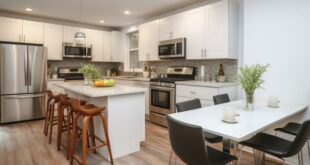Creating a home office that helps you stay productive and organized is essential if you want to maximize your productivity.
A well-designed home office should be comfortable, functional, and free of clutter. It should also be tailored to suit your individual needs and preferences.
Setting up an ultimate home office doesn’t have to be complicated or expensive; it just takes some careful planning.
We’ll look at the key elements for creating the perfect workspace—from furniture and lighting to technology and organizational tools—and discuss how you can create an environment that will help make working from home more enjoyable and efficient.
Layout and Furniture
Creating an ideal home office layout depends on your specific needs and the size of the space you have available.
Start by considering how much space you’ll need for furniture, storage, and equipment such as a printer.
Then decide which pieces of furniture will best suit your needs and fit into the designated area.
Depending on what type of work you do, you may want to include items such as a desk, filing cabinet, bookcase, chair, and/or sofa.
Choose furniture that suits your style, provides comfort and support for long working hours, and is designed to maximize the available space.
Lighting
Lighting plays an important role in your home office.
Natural light is great if you have access to it, but artificial lighting should also be incorporated into the design of your workspace.
Make sure that lights are positioned correctly, so they don’t cause any eye strain or glare on computer screens or other surfaces.
Task lighting is a useful addition for activities such as writing and reading; consider adding a desk lamp or wall sconces for this purpose.
You should also make sure to have adequate overhead lighting for general illumination when needed.
Technology
Your home office will be more efficient if you have the right technology tools and equipment. Start by considering which devices you need for your work tasks.
This could include a desktop computer, laptop, printer, scanner, and other necessary devices such as a router and modem.
Make sure that all of these items are compatible with one another and use the same type of software or operating system.
You should also consider investing in additional hardware such as an ergonomic keyboard and mouse to ensure comfort during extended use.
Make sure that your internet connection is reliable for online meetings and video.
Organization
Organization is key to creating a functional home office.
Consider what types of organizational tools you need to help you stay on top of projects, tasks, and deadlines.
This could include items such as filing cabinets, bins, boxes, and desk organizers.
You’ll also want to make sure that you have a dedicated spot for items such as mail, bills, and documents.
This will help keep your workspace free of clutter and ensure easy access when needed.
Consider incorporating software or online applications into your organizational system for tasks such as scheduling appointments or managing projects.
Epoxy Flooring
Epoxy flooring is an ideal choice for a home office because of its beauty, durability, and ease of maintenance.
Epoxy floors are made up of layers of resin and hardener that form a durable, waterproof surface when mixed together and applied to the base layer.
This material can withstand high traffic levels, heavy furniture loads, moisture, stains, and more. It is also available in a variety of colors, so you can create a unique look for your home office
Epoxy floors are to clean and maintain, making them an ideal choice for those who want to keep their workspace looking its best.
Epoxy flooring is cost-effective, low maintenance, and highly resistant to staining and wear, making it an ideal choice for those looking for a sleek yet practical workspace.
An epoxy floor can give your home office the perfect blend of style and function.
Ergonomics
Ergonomics is an important factor when it comes to designing a home office.
Ergonomic furniture and equipment should be chosen with comfort in mind, as it can reduce fatigue and help to avoid injury or strain.
Consider using ergonomic chairs that provide adequate support for your back, adjustable height desks that make it easy to switch from sitting to standing, and ergonomic keyboards and mice that put your wrists in a more neutral position.
Opt for adjustable monitors that can be moved up or down for comfortable viewing angles, and use an anti-glare filter on screens when possible.
Make sure your desk has ample room for all of the necessary items such as a computer, phone, printer, and other office equipment.
Proper organization of your workspace can also help to reduce strain on the body by making it easier to access needed items without having to reach or bend awkwardly.
Taking the time to design a workspace that is comfortable and ergonomic will result in improved focus, productivity, and wellbeing when working from home.
Design Elements
Creating a workspace that is both functional and aesthetically pleasing is important when designing a home office.
Consider the look and feel you want for the room, as this will influence the elements you include.
If you want a modern, minimalistic look add in items such as sleek desks, chairs, and storage pieces with clean lines in neutral colors. Incorporate accent pieces such as a rug, artwork, or plants to add texture and color.
If you prefer a more traditional style, opt for wooden pieces with carved details and warm hues. Or, create a cozy workspace with vintage furniture pieces and unique accessories.
Consider adding in materials that have acoustic properties such as rugs or sound-absor wall hangings, to reduce noise levels in the room.
Closing Remarks
Creating the perfect home office requires careful consideration of many factors.
From choosing ergonomic furniture and equipment to designing a workspace that is both visually appealing and functional, there are plenty of ways to make your space comfortable and conducive for productivity.
With these tips in mind, you can create an inviting environment that will inspire creativity while allowing you to work efficiently from the comfort of your own home.
A well-designed home office should be tailored specifically to suit your individual needs so take some time to think about what works best for you before getting started on creating your ideal workspace!
 khamush.com Lifestyle | Motivation | Poems
khamush.com Lifestyle | Motivation | Poems




